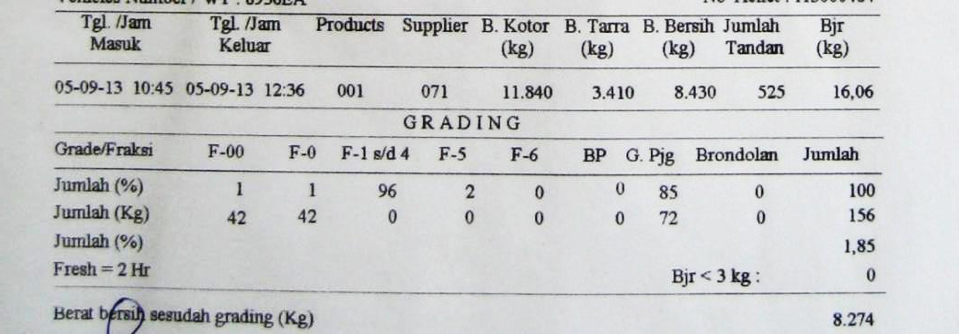Difference between revisions of "Sustainable Oil Palm Farming / Grading and sorting process"
(Published from sandbox) |
(No difference)
|
Revision as of 22:31, 10 October 2016
Download: Module 2: Harvesting, Grading, Transport
In the palm oil supply chain, farmers or plantation companies sell oil palm fruit to mills, and mills extract the oil (CPO) and sell it to a national or international buyer.
| Note: Everyone will get a better price if the harvested fruit bunches are according to standard. Good bunches are of correct ripeness, correct size, not damaged by pest or insects, without long stalks, and delivered to the mill within 24 hours of harvesting. |
In Indonesia, the government decides every month what price the mills should pay for fresh fruit bunches. The official oil palm fresh fruit bunch price depends on the following factors (see Figure 2):
- The crude palm oil price;
- The palm kernel oil price;
- The age of the bunches (due to its influence on the oil extraction rate)
- The percentage of the selling price that goes to the farmers (also known as ‘k’).
Mills have two systems to compensate for low oil content or poor oil quality, namely grading and sorting. Grading is usually done once a month while sorting is done for every truck that arrives at the mill. Grading and sorting of oil palm fruit bunches normally follow the procedure below:
- Specialised staff from the mill take a sample of fruit bunches (for example, 10% of the bunches).
- The fruit are examined to assess the quality of the fruit bunches .
- Poor quality fruit bunches, for example bunches that are unripe or very small, are given a deduction (usually in kilograms) because they produce less oil. Empty bunches are rejected.
Grading is done once a month to decide on a general deduction that is given to everyone who delivers to the mill (including the companies). Sorting is done for every truck to determine the deduction for that truck, only.
So, each delivery gets two deductions: the one from the grading and the one from the sorting.
Example of deductions given by sorting
Figure 3 shows a sorting form from a mill, on which the quality of the different bunches is recorded, and the deductions have been calculated.
Understanding the sorting form
- The total weight of the fruit bunches in the truck is 8430 kg (column ‘B. Bersih (kg)’).
- 96% of the bunches are ‘good’ (column ‘F-1 s/d 4’).
- 1% of the bunches are unripe (column ‘F-00’), therefore a deduction of 42 kg has been given.
- 1% of the bunches are underripe (column ‘F-0’), therefore, a deduction of 42 kg has been given.
- 2% of the bunches are overripe (column ‘F-5’) but no deduction has been given.
- For the presence of long stalks, a deduction of 72 kg has been given (column ‘G. Pjg’).
- There are no small bunches weighing less than 3 kg (line ‘Bjr < 3 kg’) so no additional deduction has been given.
- The total deduction is 156 kg, or 1.85 percent of the total weight.
- With a fresh fruit bunch price of 1.6 million IDR per tonne, IDR 249600 has been lost, mostly due to harvesting bunches too soon or not cutting the frond stalk short enough.
Acknowledgements
The material from Grading and sorting process is sourced from Smallholder Oil Palm Handbook and put together by Lotte Suzanne Woittiez (Wageningen Universit) and Haryono Sadikin, Sri Turhina, Hidayat Dani, Tri Purba Dukan, and Hans Smit (SNV) in August 2016. See Module 2: Harvesting, Grading, Transport for more information.





